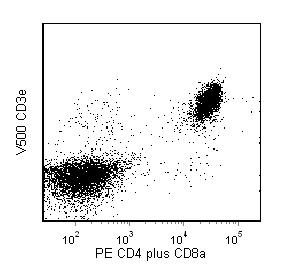-
Your selected country is
Middle East / Africa
- Change country/language
Old Browser
This page has been recently translated and is available in French now.
Looks like you're visiting us from {countryName}.
Would you like to stay on the current country site or be switched to your country?


.png)

Two color flow cytometric analysis of CD272 expression on mouse bone marrow cells and splenocytes. Mouse bone marrow cells (Left Panel) were stained with PE Hamster Anti-Mouse CD272 (Cat. No. 563774) and APC-Cy™7 Rat Anti-Mouse CD45R/B220 (Cat. No. 552094). Splenic leucocytes (Right Panel) were stained with PE Hamster Anti-Mouse CD272 and BD Horizon™ V500 Syrian Hamster Anti-Mouse CD3e (Cat. No. 560771) antibodies. The two-color flow cytometric dot plot show the correlated expression patterns of either CD45R/B220 or CD3e versus CD272 for gated events with the forward and side light-scatter characteristics of viable cells. Flow cytometric analysis was performed using a BD LSRFortessa™ Cell Analyzer System.
.png)

BD Pharmingen™ PE Hamster Anti-Mouse CD272
.png)
Regulatory Status Legend
Any use of products other than the permitted use without the express written authorization of Becton, Dickinson and Company is strictly prohibited.
Preparation And Storage
Product Notices
- Since applications vary, each investigator should titrate the reagent to obtain optimal results.
- An isotype control should be used at the same concentration as the antibody of interest.
- Caution: Sodium azide yields highly toxic hydrazoic acid under acidic conditions. Dilute azide compounds in running water before discarding to avoid accumulation of potentially explosive deposits in plumbing.
- For fluorochrome spectra and suitable instrument settings, please refer to our Multicolor Flow Cytometry web page at www.bdbiosciences.com/colors.
- Cy is a trademark of GE Healthcare.
- Please refer to www.bdbiosciences.com/us/s/resources for technical protocols.
Companion Products

.png?imwidth=320)


The HMBT-6B2 monoclonal antibody specifically binds to CD272 which is also known as B- and T-lymphocyte attenuator (BTLA). CD272 is a type 1 transmembrane glycoprotein and a member of the Ig superfamily. CD272 is variably expressed on developing and mature T and B lymphocytes, NKT cells, NK cells, macrophages and dendritic cells. CD272 expression is upregulated by activated T cells including Th1, Th2, and T follicular helper cells and by anergic T cells. CD272 is structurally similar to CD152/CTLA-4 and CD279/PD-1 and functions as a coinhibitory receptor for B and T cell responses. Herpesvirus entry mediator (HVEM), also known as CD270 and LIGHT-R, has been identified as a ligand for CD272. The crosslinking of CD272 by HVEM inhibits T-cell proliferation and cytokine production.

Development References (7)
-
Han P, Goularte OD, Rufner K, Wilkinson B, Kaye J. An inhibitory Ig superfamily protein expressed by lymphocytes and APCs is also an early marker of thymocyte positive selection. J Immunol. 2004; 172(10):5931-5939. (Biology). View Reference
-
Hurchla MA, Sedy JR, Gavrieli M, Drake CG, Murphy TL, Murphy KM. B and T lymphocyte attenuator exhibits structural and expression and is highly induced in anergic CD4+T cells. J Immunol. 2005; 174(6):3377-3385. (Biology). View Reference
-
Ishida W, Fukuda K, Kajisako M, et al. B and T lymphocyte attenuator regulates the development of antigen-induced experimental conjunctivitis. Graefes Arch Clin Exp Ophthalmol. 2012; 250(2):289-295. (Immunogen: In vivo exacerbation). View Reference
-
Nurieva RI, Chung Y, Martinez GJ, et al. Bcl6 mediates the development of T follicular helper cells. Science. 2009; 325(5943):1001-1005. (Biology). View Reference
-
Sedy JR, Gavrieli M, Potter KG, et al. B and T lymphocyte attenuator regulates T cell activation through interaction with herpesvirus entry mediator. Nat Immunol. 2005; 6(1):90-98. (Biology). View Reference
-
Watanabe N, Gavrieli M, Sedy JR, et al. BTLA is a lymphocyte inhibitory receptor with similarities to CTLA-4 and PD-1. Nat Immunol. 2003; 4(7):670-679. (Biology). View Reference
-
Watanabe N, Nakajima H. Coinhibitory molecules in autoimmune diseases. Clin Dev Immunol. 2012; 2012:1-7. (Biology). View Reference
Please refer to Support Documents for Quality Certificates
Global - Refer to manufacturer's instructions for use and related User Manuals and Technical data sheets before using this products as described
Comparisons, where applicable, are made against older BD Technology, manual methods or are general performance claims. Comparisons are not made against non-BD technologies, unless otherwise noted.
For Research Use Only. Not for use in diagnostic or therapeutic procedures.
Report a Site Issue
This form is intended to help us improve our website experience. For other support, please visit our Contact Us page.